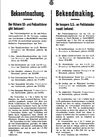

|
|
|
|
|
|
Limburg 1940-1945,
Main Menu
1940-1945. The resistance in the dutch province of Limburg
Kerkrade
Communiqué of the High Führer of the SS and the police of the provinces of Limburg and North Brabant on the death sentences related to the strike in the mines from April to May 1943.
On July 1, 1946, a mass grave containing seven bodies was discovered in Wellerlooi (municipality of Bergen) on the Wellse Heide (now the nature reserve Landgoed de Hamert). There an oak wood cross stands on a red brick wall, the resistance monument, as a permanent reminder of the seven resistance fighters Han Boogerd, Bob Bouman, Leendert Brouwer, Pieter Ruyters, Reinier Savelsberg, Meindert Tempelaars and Servaas Toussaint, shot in connection with the strike in 1943.
In the Dutch coal mining area this strike was called miner’s strike. The actual mining area stretched from Geleen to Kerkrade, but a not inconsiderable number of miners lived outside of it, for example in Valkenburg. In Maastricht, the strike was initiated by government employees. Later bank staff joined in. When the postal workers also wanted to go on strike, the members of the nazi party NSB present forced them to continue working with all sorts of threats. Long queues of people immediately formed in front of all the counters, wanting to buy one single 1-cent stamp. This way the post office was closed too. The factories also joined.
In the beginning there was a party atmosphere. People flocked to the pubs and didn’t suspect (or didn’t want to think about it) that the occupiers would of course not tolerate this and that there would be victims. These events made it clear that attempts to lure the Dutch with the status of an “Aryan brother nation” had failed.
The miners’ strike was part of the strikes of April-May 1943. The background was the return of Dutch soldiers to captivity, planned by the occupiers, to be put to work in the German war industry. They were the transition to a more massive resistance movement throughout the Netherlands, including the province of Limburg. The strikes were brutally suppressed, but the resistance organizations gained more new members (perhaps even because of this?). For the majority of Dutch Jews, however, it was already too late. :(
Kerkrade is the easternmost town in the Dutch mining district. Coal mining started here. It played such an important role that a statue has been dedicated to it: D’r Joep, see right. But this Joe has nothing directly to do with the miners’ strike.
Click on the image to the left, to read more about this item.
During the liberation of South Limburg, the advance of the Allies came to a halt for a time. Kerkrade was suddenly front city and the population of East Kerkrade had to be evacuated. Because the Germans had confiscated all vehicles, this was done with wheelbarrows and the like. Doctor Kreijen of the Sint-Jozef Hospital managed by negotiation, also to get the remaining patients and staff through a corridor to liberated territory. Click on his photo to read more about it.
Liberated: 1944-10-05
| The fallen resistance people in Limburg Kerkrade – 8 pers. | ||
| Creusen,
Jan Willem Wiel "oom Kees" | ∗ 1893-07-31 Kerkrade † 1945-05-31 Bergen-Belsen | - Underground Press - Couriers of the Resistance - Kerkrade - Raad van Verzet (RVV) - According to Cammaert [1], Wiel Creusen was a civil servant at the Distribution Office [2] and former chairman of the local Unie. [3] He was also involved in helping, among … wall: left, row 26-01 |
| Goossen,
Theo J.M. Harry van Benthum | ∗ 1917-10-20 Bergh † 2000-02-06 Heerlen | - Aid to People in Hiding L.O. - Kerkrade - Survivors - BS (Domestic Forces) - Leader of the subdistrict Kerkrade of the resistance organisation LO. Worked together the Auβenministerium (a group that repatriated students forced to work in Germany to the Netherlands). … More in our story Resistance in Valkenburg |
| Hillebrand,
Johann | ∗ 1922-07-12 Herzogenrath (D) † 1944-06-10 Liège | - Secret Army (B) - Belgium - Kerkrade - Johann Hillebrand was a miner in Belgium. Belonged there to the resistance organization wall: left, row 25-01 |
| Horstmann,
Henderich Hein | ∗ 1902-01-30 Börger † 1943-05-04 Maastricht | - Kerkrade - April-Mei-stakingen, 1943 - Henderich Horstmann was born in Börger, Germany, about 50 km from Emmen in the Netherlands. He and his wife Klazina Koelman came to Kerkrade from Emmen on December 15, 1925. [1#3] As a … wall: left, row 25-02 |
| Kerres,
Hub. | ∗ 1924-06-30 Kerkrade † 1944-08-30 Buchenwald | - Engelandvaarders - Studenten - Kerkrade - The student Hubert Joseph Kerres lived in Kerkrade. His father Mathias came from the German-speaking Eynatten near Eupen, which is now Belgian again, mother Maria Hubertina from Horbach, from … wall: middel, row 13-02 |
| Lochtman,
Hein | ∗ | - The clergy - Aid to People in Hiding L.O. - Kerkrade - Maastricht - On the wall of the resistance chapel in Valkenburg there is also a Hein Lochtman under Maastricht, as vicar in Limmel. This is the same person. wall: left, row 25-03 |
| Lochtman,
Hendrik Joseph Hein | ∗ 1911-09-02 Kerkrade † 1945-02-27 Bergen Belsen | - The clergy - Aid to People in Hiding L.O. - Kerkrade - Maastricht - Hein Lochtman was a vicar in Limmel from 1940 and member of LO in Maastricht. He hid people in … wall: left, row 33-04 |
| Ommeren,
van Godefridus Frits | ∗ 1919-11-14 Venlo † 1944-09-11 Heerlen | - April-Mei-stakingen, 1943 - People in hiding - Kerkrade - Frits van Ommeren was an apprentice train driver with the Dutch railroad company. After the strike he went into hiding and was shot during a raid by the SS on the Weltermolen … wall: left, row 25-04 |
 D’r Joep
D’r Joep
